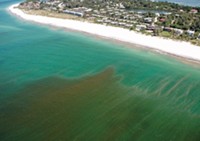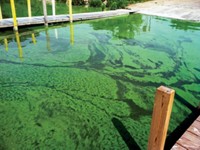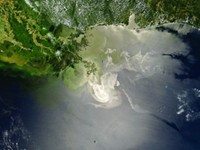Advertisement
Grab your lab coat. Let's get started
Welcome!
Welcome!
Create an account below to get 6 C&EN articles per month, receive newsletters and more - all free.
It seems this is your first time logging in online. Please enter the following information to continue.
As an ACS member you automatically get access to this site. All we need is few more details to create your reading experience.
Not you? Sign in with a different account.
Not you? Sign in with a different account.
ERROR 1
ERROR 1
ERROR 2
ERROR 2
ERROR 2
ERROR 2
ERROR 2
Password and Confirm password must match.
If you have an ACS member number, please enter it here so we can link this account to your membership. (optional)
ERROR 2
ACS values your privacy. By submitting your information, you are gaining access to C&EN and subscribing to our weekly newsletter. We use the information you provide to make your reading experience better, and we will never sell your data to third party members.
Environment
Of Algae And Dead Zones
Legislation would create new federal programs to control size, incidences of harmful blooms
by Cheryl Hogue
October 5, 2009
| A version of this story appeared in
Volume 87, Issue 40

Massive blooms of algae periodically appear in bodies of water ranging in size from small prairie potholes to Lake Erie to the Gulf of Mexico. These excessive growths of algae can cause serious economic and ecological damage. Now, some members of Congress want to create a federal program to control their occurrence and size.
The movement is being led by the Science & Technology Committee of the House of Representatives, which considers algal blooms to be “one of the most scientifically complex and economically significant coastal management issues facing the nation.” Specifically, the panel’s Subcommittee on Energy & Environment adopted a bill, H.R. 3650, last week that would create two national programs, coordinated by the National Oceanic & Atmospheric Administration (NOAA), on harmful algal blooms and hypoxia. One program would, at the request of states, respond to blooms or hypoxia. The other would develop a network for observing, monitoring, and forecasting blooms or hypoxia.
The legislation would build on 1998 and 2004 laws regarding research on harmful algal blooms and hypoxia. Under H.R. 3650, the new federal programs would develop comprehensive regional action plans to predict, control, and prevent harmful blooms and dead zones.
Algal blooms are varied. Some are responsible for what are popularly called red tides or brown tides, producing toxins that accumulate in fish or shellfish and that can sicken human swimmers and kill dogs that go in the water. These red or brown tides can shut down fisheries and put a serious crimp in tourism.
In other blooms, the algae eventually die in great numbers and are eaten by bacteria that consume much of the oxygen in the water, leading to vast areas of oxygen-poor water. These areas are called dead zones. And although fish are able to swim away from the hypoxic areas to waters richer in oxygen, slow-moving bottom-dwelling creatures, such as crabs, perish.
Some algal blooms are fertilized by nitrogen and phosphorus runoff from agricultural, suburban, and urban areas, such as the blooms that create the Gulf of Mexico’s dead zone each summer. Other blooms stem from changes in temperature, sunlight, or other environmental factors that give a particular species of algae an edge, allowing them to out-compete other aquatic microorganisms in the quest for nutrients.
The House subcommittee probed ways to prevent and control algal blooms during a hearing last month. There, they heard from experts on blooms from around the U.S.
Harmful algal blooms and hypoxia disrupt fisheries, recreation, or tourism in many U.S. communities each year—and not just those along the coasts or Great Lakes. Harmful algal blooms occur in every state, according to Robert Magnien, director of NOAA’s Center for Sponsored Coastal Ocean Research.
Blooms in freshwater are different from those in marine ecosystems and must be considered separately, pointed out Greg L. Boyer, professor of biochemistry at the State University of New York College of Environmental Science & Forestry, in Syracuse. Although marine blooms are composed of phytoplankton, most freshwater blooms are blue-green algae, which are photosynthetic bacteria.
There is also a difference in which agency regulates various bodies of water, Boyer noted. Therefore, he asked the subcommittee to include the Environmental Protection Agency in the proposed new federal programs on harmful algal blooms. Currently, NOAA has jurisdiction over blooms in marine areas and the Great Lakes. But other freshwater areas, from prairie potholes to constructed lakes, fall under EPA’s purview, he said.
Meanwhile, progress in controlling harmful algal blooms in marine ecosystems has been “regrettably slow,” said Donald M. Anderson, senior scientist in the Woods Hole Oceanographic Institution’s biology department. Laboratory studies have shown how bacteria, viruses, chemicals, and clay minerals can help kill off marine algal blooms. But this research has not been continued into the field, Anderson said.
“Given a choice, scientists will propose fundamental research on [algal] bloom dynamics rather than undertake the risky, controversial, and highly visible task of trying to control a bloom,” Anderson told the subcommittee. He recommended federal funding target investigations on slowing and stopping growth of harmful algal blooms.
H.R. 3650, which enjoys bipartisan support, next goes to the full Science & Technology Committee for consideration.





Join the conversation
Contact the reporter
Submit a Letter to the Editor for publication
Engage with us on Twitter